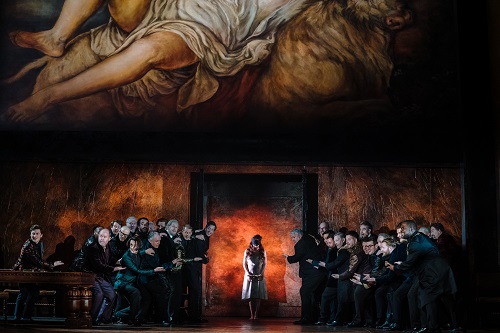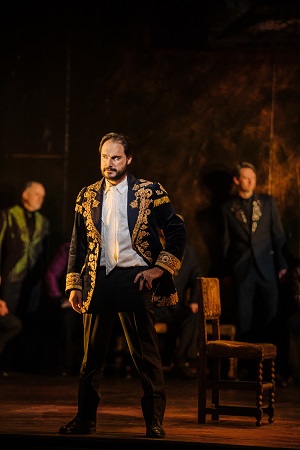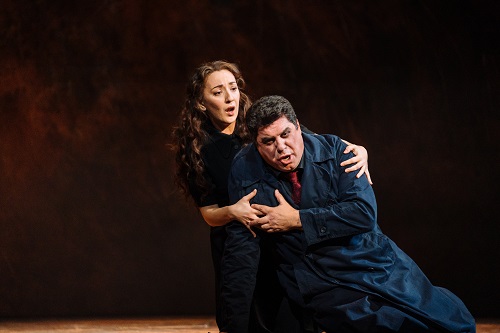In his first production since taking up his appointment as Director of Opera in 2017,Oliver Mears’s thought-provoking staging clearly acknowledges Rigoletto as a timeless classic. His presentation debuted in September 2021 when it replaced David McVicar’s production, one that had earned a colourful reputation since opening at the Royal Opera House in 2001. Exchanging debauchery for violence, this is a no-frills outing yet freshened by insightful ideas on misguided loyalty, power and vengeance.
Mears’s Duke of Mantua is not just a serial seductor but also a collector of Old Masters, first suggested during the Prelude by a frozen tableau depicting Caravaggio’s innocent slaughter in The Martyrdom of St Matthew. Replacing the saint, a young woman is dressed in virginal white – Mears telling us everything in a single chiaroscuro effect that is brilliantly lit by Fabiana Piccioli. It’s an arresting image and, arguably, the most memorable of the evening. Once into the first scene proper, a second image is unveiled; Titian’s Venus of Urbino, its sensual charge reflecting the female chorus on stage eager to enjoy the depravity of the Duke’s party. Further eroticism adorns Act Two with another Titian, The Rape of Europa, now hanging portentously above the door to the Duke’s bedchamber where his abducted daughter Gilda is held captive.

His courtiers are stylishly attired by Ilona Karas in a mix of Medici magnificence, as if belonging to the Caravaggio, and modern dress suggestive of a non-specific time frame. Only in the Third Act is the hitherto empty stage dominated by a riverbank tavern, a plain structure fashioned by set designer Simon Lima Holdsworth that does well for Sparafucile’s drunken sister Maddalena. So far so good, though with just a couple of unnecessary moments: Act One’s gratuitous maiming of Monterone, admittedly underlining the Duke’s pitiless disposition, and Act Three’s storm where the repeated flashing of house lights felt too close to am-dram. We got the message of the storm early on and anyone actually bothering to listen to the orchestral score would have noticed Verdi’s pictorialism with the flute’s jagged downward gestures.
In the title role Luca Salsi gives a well-defined portrait; his Rigoletto both vengeance-fuelled and tender in his filial devotion. Vocally, he fulfilled the role with ample carrying power, and if its core was never actually beautiful, his smoky baritone sustained a demanding role notorious for its high tessitura. He balanced well in duets, touchingly so in ‘Ah! veglia o donna’ from Act One, and was at his best in his outburst to the courtiers at the end of Act 2. His final scene with his daughter brought out some genuine feeling, his loss and despair the emotional highlight of the evening.

As the playboy Duke, Francesco Duero is dangerously vicious but vocally disappointing, sounding under projected in his opening ditty ‘Questa o quella’, only later going full pelt in Act Two’s ‘Ella mi fui raplita’. That said, even at his best Duero seems to be a pocket tenor – notwithstanding ringing tones and idiomatic in an Italian way – with little in his voice to raise the eyebrows. His ‘La donna e mobile’, while technically secure, drew only tepid applause.
It was left to Rosa Feola’s Gilda to raise the emotional temperature which she did effortlessly from her first virginal appearance. It was a role she inhabits with ease, moving from not-so- innocent teenager to determined, lovelorn protector stealing our hearts with her rapt singing. She has an unaffected voice with an impeccable technique: ‘Caro nome’ was flawlessly executed, her flexible tone well-suited for its ornamentation. But, despite her heart-wrenching dying phrases, I listened in vain for any emotional tension in Act Three’s Quartetto, its intensity weakened by the distance between the singers, where both the Duke and Aigul Akhmetshina’s Maddalena were too far back to make any significant impact.

Amongst other roles, Evgeny Stavinsky’s dark-hued Sparafucile was suitably sinister, bringing plenty of menace in his encounters with the Duke and matching him vocally in their Act One duet. Cameo roles, including Kseniia Nikolaieva, (Giovanna) and Dominic Sedgwick (Marullo), were well-served and the men from the Chorus were on superb form, their gang-like manoeuvres devised by choreographer Anna Morrissey particularly effective.
Stefano Montanari proved his Verdian credentials in the pit with an account that revealed a fine ear for balance, mostly favourable tempi and a gift for coaxing much sensitive playing with some especially eloquent woodwind contributions. Perhaps a second revival might produce a few more UK singers, and maybe all three principal roles will have the wow factor.
David Truslove
Verdi: Rigoletto
Duke of Mantua – Francesco Demuro, Rigoletto – Luca Salsi, Gilda – Rosa Feola, Sparafucile – Evgeny Stavinsky, Maddalena – Aigul Akhmetshina, Giovanna – Kseniia Nikolaieva, Count Monterone – Phillip Rhodes, Marullo – Dominic Sedgwick, Borsa – Egor Zhuravskii, Count Ceprano – Blaise Malaba, Countess Ceprano – Amanda Baldwin, Page – Louise Armit, Court Usher – Nigel Cliffe; Director – Oliver Mears, Revival Director – Danielle Urbas, Conductor – Stefano Montanari, Set designer – Simon Lima Holdsworth, Costume designer – Ilona Karas, Lighting designer – Fabiana Piccioli, Movement Director – Anna Morrissey, Chorus and Orchestra of the Royal Opera House.
Royal Opera House, Covent Garden, London; Monday 21st February 2022.
ABOVE: Rigoletto ROH 2022 © Helen Murray